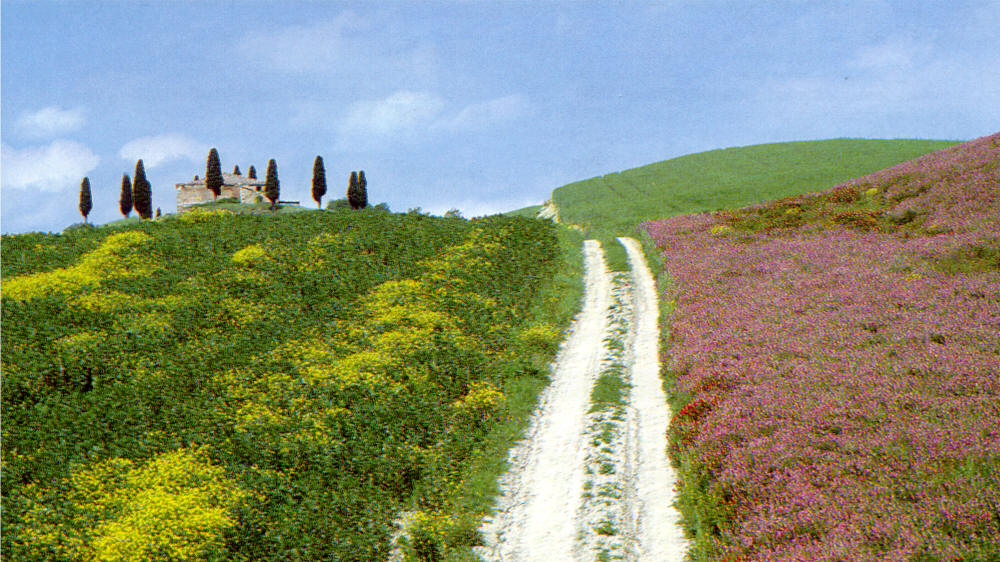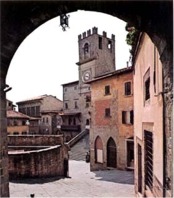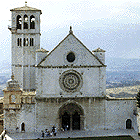Guided Rambling Holidays
Eastern Tuscany, Italy
Gentle to moderate rambles with English speaking guides.



|
Itinerary:
Meeting Point: Florence Santa Maria Novella Rail Station 4.00 pm. Day
Three:
We start at the very top of
the hill in Cortona where we find an old church dedicated to St Margherita,
protector of the town. From here we make our way along small roads
with magnificent views of the Val de Chiana. Our goal is the quiet
Eremo delle Celle, a picturesque hermitage built on the shore of a stream
around the cave where St Francis of Assisi came regularly on retreat during
his long journeys on foot. It is an ideal spot for our picnic. Day Four: We start early to head to Casentino National Park, one of the most important forests in Europe. It is rich in flor and fauna but also in art and history. Following quiet roads and woodland paths shaded by beech and fir trees, we walk around Mounte Penne to reach the remote sanctuary of La Verna where St. Francis spent much of his life. The old churches are decorated with unique masterpieces by the great artist Della Robbia. In the afternoon we enjoy another peaceful walk down to the town of Chiusi della Verna. Easy walk 5 km Harder walk 9 km Day Five: Today we visit Assisi a UNESCO World Heritage site and home of St Francis, the patron saint of today's environmental movement. At the Hermitage of St Francis there is a tree which is said to have shaded St Francis while he preached to the birds. We start with a walk to enter Assisi following the footsteps of St Francis along the last leg of what is called the Franciscan Way (the walking itinerary from La Verna to Assisi). It leads through the "Bosco di St Francesco" (the wood of St Francis) which was recently restored so visitors could experience nature as it existed in the time of St Francis. The well-maintained trail leads through the "Terzo Paradiso" (Third Heaven) an artwork using 121 olive trees. Fig, nut and fruit trees have been planted evoking the gardens that were once tended by nuns. Among the peaceful woods we find a restored 13th century church, a 12th century mill and tower.The remainder of the day is free to explore the great spiritual and artistic treasures of Assisi. We suggest sampling some of the local specialties for lunch ... a creamy risotto with mascarpone cheese, grilled aubergine, deep-fried olives and zucchini flowers, sformato (a souffle) of potato and snail with porcini mushroom sauce. Try a panna cotta (a custardy cream with a sauce of hazelnuts, wine and honey) or a sublime tiramisu. Day Six: Today our walk is near Lake Trasimeno where, in 217 BC, the Cathaginians led by Hannibal defeated the Roman army. Along the way are historical landmarks describing the great battle that was one of the largest and most successful ambushes in military history. Our walk is on the hills above Lake Trasimeno with spectacular views. We end the walk at the small fortified town of Passignano sul Trasimeno and have time to explore or relax over a cappuccino before heading back to Cortona. Easy walk 8 km Harder walk 10 km Day Seven: We save the best for last. Our bus takes us south to the hilltop town of Castiglioncello del Trinoro and from this extremely panoramic spot we walk towards La Foce with its spectacular renaissance gardens. La Foce was the home of the author Lady Iris Origo who wrote in her book "War in the Val D'Órcia" of her World War II experiences as an Englishwoman living in Italy and how she risked her life daily hiding escaped prisoners and war orphans from the Nazis. The Val D'Órcia is the Tuscan countryside of your imagination with cypress-lined roads and rolling golden hills. We continue through beautiful countryside to the small medieval fortress village of Castelmuzio with its narrow streets and just outside the village stands a church that has a recorded history since 715AD although it is known to stand on what was once a Roman temple which stood on an earlier Etruscan site of worship. The part we see today was built in 1285AD. Opposite the village stands the serene old monastery of Sant Anna Camprena where the film "The English Patient" was filmed. At the end of the day we return to Cortona for a farewell dinner. Easy walk 7 km Harder walk 10 km Day Eight: Return by private bus to the Florence Rail Station arriving about 11.00 am.
|
|
||||||||